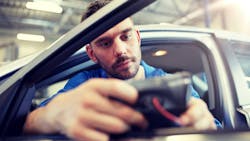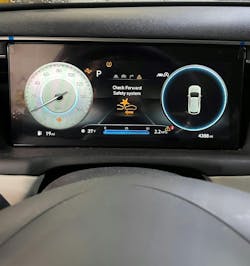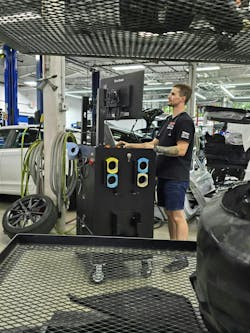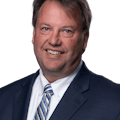Insurers and all payers want repairers to limit the number of supplements. But how do we do so and remain profitable? It’s all about our processes, of course.
Opportunity – Reducing Supplements
Given the highly variable nature of collision repair damage and the complexity of repairs, it is nearly impossible to write a 100% complete estimate for repairs in your first attempt. This article will offer some tips which repairers around the world have successfully used to minimize the number of supplements after the original repair plan is created.
The basic premise of this article is that the more you can do up front, the fewer delays you will experience due to supplements written AFTER the initial repair plan. However, to get the most of this article's content, you will have to open your mind to some refined processes which have been applied in our industry. There are quite a few steps prior to the enhanced repair plan which need to be refined to set you up to prevent supplements later.
Assignment Follow-up Call
Whether you are calling the customer after receiving an assignment or they call you, the first step in reducing supplements -- after getting accurate contact and vehicle information -- is to act as an advisor to the customer. Take control of the transaction and guide them on a path to the fastest and most hassle-free process. Don’t say, “Stop by any time and we will take a look at it.”
We need to engage the customer by asking about the damage. This helps usunderstand where the vehicle was damaged. Ask secondary follow-up questions to better understand if the vehicle is safe to drive. If the vehicle is not safe to drive, either warn them of the safety risk or help them have the vehicle towed to the repair center. If it is safely drivable, ask them to provide digital images of the vehicles damage so you can use your AI estimating tool to get a preliminary estimate created prior to their arrival. Then, schedule them in for an inspection (not estimate appointment). That no-cost advanced inspection allows them to get the vehicle in the shop to ask the technicians to look for hidden or missed damage. This advanced inspection could include minor disassembly to see if behind-the-scenes parts are damaged and to inspect vehicles systems by performing a pre-scan on crucial accident-avoidance systems to ensure they are working as designed. The end goal is to get the parts preordered so critical parts can be onsite when they drop the vehicle off for repairs.
Advanced Inspection
As we have accurate vehicle information and have scheduled advanced inspection appointments, we can greet the customer by name, build rapport, understand their marketing source, and learn of their personal repair choices and vehicle repair needs. We pass this information to the service advisor, who asks for the keys and moves the vehicle to the repair planning area. The technician and service advisor can then compare the AI estimate assumptions to the actual damage, use a paint spectrophotometer to verify the paint code and paint system (for pre-painting), they use a borescope to see behind things or to perform minor disassembly (and reassembly, if possible).
Often, repairers take photos of dash lights and even pre-scan ADAS systems to ensure they are performing as designed. Any prior unrelated damage is assessed and added-value upsells are documented as an opportunity in the estimating system.
You can review the various packages with the customer and get them scheduled in on a specific date. To expedite the repairs, you would then ask them to sign the work authorization and ask for a credit card deposit (e.g. $200) for the parts to be ordered (often more than $2,000 on a $5,000 repair). Those parts are then ordered and their receipt is monitored. If the parts critical to repair planning and body don’t arrive prior to the vehicle’s drop-off date, the date is moved back.
Expedited Check-in
Again, we review incoming vehicles and attempt to greet them by name upon arrival. We thank them for their business and tell them of our goal of 100% CSI or to earn a 10. Then, the detailers retrieve the vehicles, move into the receiving station, prewash, and attach the pre-scan tool (if not done during RP). The painter (knowing the incoming schedule) asks the repair planner to help mirror match parts and then send them to the painter for edging both sides (in England, they often prepaint them) along with a form listing all parts to be painted off the vehicle in advance.
NOTE: The first supplement begins NOW!
Enhanced Repair Planning - Paint as the First Part
At some point during the enhanced repair planning process, we want the painter to review the vehicles painting needs and to offer their justification for which panels to paint and which panels to blend, this agreement informs the body technician which emblems or moldings would need R & I and the sublet is noted on the vehicle and scheduled proactively. Most importantly, they will discuss with the body technician which parts will need welding and assure there is time allowed for refinishing those areas, and where additional masking or refinishing are necessary for panels with matte or different color refinishes, they will also share their insights on the type of paint: tri-stage, quad-stage, pearl, limited-use toners needed. This prevents paint supplements later.
Enhanced Repair Planning: Body
As we begin this enhanced repair planning process, we start by pulling the vehicle into the repair planning or body tech’s stall and find a clean parts cart or tote (fully kitted with parts needed to repair plan or to complete body repairs) to dedicate to each vehicle. We position two tables nearby (R & I and replace) and the estimating cart with dual monitors. Finally, we place the pre-painted complex assembly parts on a padded stand and position the part it is replacing next to it. The estimating cart is placed between those stands and the parts cart, and nothing is placed on the parts cart until the line is added to the estimate to replace it or time to R & I the part. Parts are then transferred to the replacement part (no need for bagging and tagging). During this transfer, we take the new replacement parts on the cart and install them along with the undamaged parts from the complex assembly. If possible, we pre-test lights, window function, and so forth to verify these assemblies are complete, performing properly and cosmetically correct (headlight hue for example). This reassembly during repair planning uncovers and prevents parts and labor supplements which are necessary during, body or reassembly.
Making the repair versus replace decision on sheet metal is quite easy when you have all the information. To do that, we suggest you use PDR, glue or tab pull or the air suction pulling posts to rough pull parts to determine if you can safely repair them. Then, ask the technician to write on the vehicle to justify the repair time, or if the repair cost exceeds 75% of the parts value, to ask for a replacement to be added to the supplement.
As you reassemble these assemblies, go to your procurement tool (such as 3M Repair Stack) and input and pull all “kits” necessary to complete the repair for that make and model. Test any lights to ensure you get paid for broken or missing fasteners, bulbs, fluids, etc.
Many vehicles have plastic bumpers, and insurers will pay to attempt to safely repair them when repair costs are 75% or less of the replacement bumper cost. The odds of success are improved if historically, you have cut tabs of past disposed OE bumpers to enable a safe and cosmetically appealing repair (or customer agrees to an appearance allowance to save them $).
Once you have identified all parts necessary for replacement, order those parts from the suppliers, while requiring them to communicate with you electronically within two hours of order placement of any list price part price increases to avoid PPT supplements.
Enhanced Repair Planning: Frame and Mechanical
The assumption is that during advanced inspection or the repair planning process, vehicles going off the road or having dash lights on will be put on a lift and diagnosed for suspension or other mechanical repair needs. Some repairers prefer to have these repairs completed prior to finalizing the repair plan, as mechanics tend to replace parts to find the part which fixes the system, and those costs need to be considered in the repair planning supplement.
If the vehicle has the potential for frame or structural repairs needed, it is important to pre-pull the frame or structure to assure it pulls out. Also consider conjunctive pulls and glass breakage. Any fabrication labor should be estimated at this time. Now, and only now, do we have a chance to prevent the bulk of supplements, but we have one final step.
Auditing
Meet with the estimator/repair planner, body/frame technician, and painter to review the supplement to assure it is complete and they have solid line notes to justify each line. The assumption is that you invested the time with each carrier to update the estimate line operation codes setup to reflect agreed-upon rates or times for various operations to avoid having to double check every line. If this is a DRP claim, run the estimate through the CCC Advisor to ensure your audit score is as low as you would liketo achieve the highest possible “Estimate Quality” score.
If there are any questions by the customer or insurer about the repair approach, discuss this repair plan to agree upon the approach and assure the final repair plan meets their expectations.
Only AFTER all the above things are complete should we upload supplement 1 to the payer/insurer and call the customer with an expected delivery date.
Build-up in Body
To minimize any second supplements, the body phase will need to be redefined. The body department will not ONLY be asked to weld panels on, straighten dents and reinstall parts. Once these functions are complete on vehicles requiring interior removal, we would ask the painting to be completed on the A, B, and C pillars or core support and that the interior and underhood or trunk components be reinstalled. Leave the door handles or other parts which need to remain uninstalled if the panel’s exterior still needs to be painted.
This process of building up the repair to where it can be final reassembled within two hours not only supports getting vehicles out of the shop faster after painting, but it also minimizes the parts supplements uncovered after body repairs are completed.
Paint
As we discussed earlier, paint decisions were generally made during advanced inspection or enhanced repair planning. However, we still suggest you still have the painter take photos of what paint processes are completed to justify the times planned for should anyone question the initial repair plan.
Reassembly and ADAS Calibration
As we have established, reassembly should be pretty much done, so very few supplements should pop up here following these processes. But they do periodically pop up during post scan, calibration and test drives. So, affected pre-scanning and mechanical diagnostics can prevent or minimize supplements, but things may pop up and need to be caught before the vehicle leaves.
Quality Assurance
Interestingly, 10% of repairs priced at $10,000 or more must return for “adjustments” or “comebacks.” This could be “we-owe” parts, or it could be wind leaks or other deficiencies. Effective department-to-department quality assurance and detailed quality control checks of systems before delivery can be quite effective in minimizing these instances and the inconvenience and supplements they cause.
Conclusion
We all know it is a foregone conclusion that we will have at least one supplement on most repairs, but we hope that you consider refinements to processes such as advanced inspection, paint as the first part, enhanced repair plan with transfer of parts, the buildup in body, and enhanced quality assurance as ways to significantly reduce supplemental delays.
How do you know if you're being successful? On a periodic basis, review the estimating systems and CCC scorecard, which tracks supplement frequency and size. If you aren’t KPI-savvy, count the number of OEM and other parts invoices. They are often tied to a specific supplement and can be a visual indicator you need to “improve your processes.”
Reducing supplements will often improve repair cycle time, overall customer satisfaction, and additional volume from your insurance and other accounts!
About the Author
Steve Trapp
Steve Trapp is an internationally known consultant and speaker. His family operates a collision repair center in Wisconsin. He earned a degree in economics education and a minor in accounting from the University of Wisconsin.
After college, he worked for 3M in sales and marketing roles with the innovative 3M ARM$ training and software sales. He worked as a consultant for AutocheX doing financial consulting for a few years before joining AkzoNobel, where he started the industry’s first value-added program. While there, he started the industry’s first paint company-sponsored 20 groups and wrote numerous training programs with third-party experts on finance, marketing, selling, leadership, and other topics.
He later joined DuPont/Axalta, where he worked with Mike Anderson to manage their 20 groups and industry seminars. While at Axalta, he managed the North American Strategic Accounts SAM team and later the entire EMEA Strategic Accounts team. He followed that as senior consultant for LEAP, a global consulting firm that has presented in 10 countries and now again works for a major paint company.




